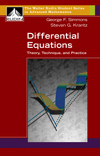 |  Differential Equations: Theory, Technique, and Practice George Simmons,
Colorado College
Steven Krantz,
Washington University St Louis
Table of ContentsPreface
1 What is a Differential Equation?
1.1 Introductory Remarks
1.2 The Nature of Solutions
1.3 Separable Equations
1.4 First-Order Linear Equations
1.5 Exact Equations
1.6 Orthogonal Trajectories and Families of Curves
1.7 Homogeneous Equations
1.8 Integrating Factors
1.9 Reduction of Order
1.9.1 Dependent Variable Missing
1.9.2 Independent Variable Missing
1.10 The Hanging Chain and Pursuit Curves
1.10.1 The Hanging Chain
1.10.2 Pursuit Curves
1.11 Electrical Circuits
Anatomy of an Application: The Design of a Dialysis Machine
Problems for Review and Discovery
2 Second-Order Linear Equations
2.1 Second-Order Linear Equations with Constant Coefficients
2.2 The Method of Undetermined Coefficients
2.3 The Method of Variation of Parameters
2.4 The Use of a Known Solution to Find Another
2.5 Vibrations and Oscillations
2.5.1 Undamped Simple Harmonic Motion
2.5.2 Damped Vibrations
2.5.3 Forced Vibrations
2.5.4 A Few Remarks About Electricity
2.6 Newton’s Law of Gravitation and Kepler’s Laws
2.6.1 Kepler’s Second Law
2.6.2 Kepler’s First Law
2.6.3 Kepler’s Third Law
2.7 Higher Order Linear Equations, Coupled Harmonic Oscillators
Historical Note: Euler
Anatomy of an Application: Bessel Functions and the Vibrating Membrane
Problems for Review and Discovery
3 Qualitative Properties and Theoretical Aspects
3.1 Review of Linear Algebra
3.1.1 Vector Spaces
3.1.2 The Concept Linear Independence
3.1.3 Bases
3.1.4 Inner Product Spaces
3.1.5 Linear Transformations and Matrices
3.1.6 Eigenvalues and Eigenvectors
3.2 A Bit of Theory
3.3 Picard’s Existence and Uniqueness Theorem
3.3.1 The Form of a Differential Equation
3.3.2 Picard’s Iteration Technique
3.3.3 Some Illustrative Examples
3.3.4 Estimation of the Picard Iterates
3.4 Oscillations and the Sturm Separation Theorem
3.5 The Sturm Comparison Theorem
Anatomy of an Application: The Green’s Function
Problems for Review and Discovery
4 Power Series Solutions and Special Functions
4.1 Introduction and Review of Power Series
4.1.1 Review of Power Series
4.2 Series Solutions of First-Order Differential Equations
4.3 Second-Order Linear Equations: Ordinary Points
4.4 Regular Singular Points
4.5 More on Regular Singular Points
4.6 Gauss’s Hypergeometric Equation
Historical Note: Gauss
Historical Note: Abel
Anatomy of an Application: Steady-State Temperature in a Ball
Problems for Review and Discovery
5 Fourier Series: Basic Concepts
5.1 Fourier Coefficients
5.2 Some Remarks about Convergence
5.3 Even and Odd Functions: Cosine and Sine Series
5.4 Fourier Series on Arbitrary Intervals
5.5 Orthogonal Functions
Historical Note: Riemann
Anatomy of an Application: Introduction to the Fourier Transform
Problems for Review and Discovery
6 Partial Differential Equations and Boundary Value Problems
6.1 Introduction and Historical Remarks
6.2 Eigenvalues, Eigenfunctions, and the Vibrating String
6.2.1 Boundary Value Problems
6.2.2 Derivation of the Wave Equation
6.2.3 Solution of the Wave Equation
6.3 The Heat Equation
6.4 The Dirichlet Problem for a Disc
6.4.1 The Poisson Integral
6.5 Sturm-Liouville Problems
Historical Note: Fourier
Historical Note: Dirichlet
Anatomy of an Application: Some Ideas from Quantum Mechanics
Problems for Review and Discovery
7 Laplace Transforms
7.1 Introduction
7.2 Applications to Differential Equations
7.3 Derivatives and Integrals of Laplace Transforms
7.4 Convolutions
7.3.1 Abel's Mechanical Problem
7.5 The Unit Step and Impulse Functions
Historical Note: Laplace
Anatomy of an Application: Flow Initiated by an Impulsively-Started Flat Plate
Problems for Review and Discovery
8 The Calculus of Variations
8.1 Introductory Remarks
8.2 Euler’s Equation
8.3 Isoperimetric Problems and the Like
8.3.1 Lagrange Multipliers
8.3.2 Integral Side Conditions
8.3.3 Finite Side Conditions
Historical Note: Newton
Anatomy of an Application: Hamilton’s Principle and its Implications
Problems for Review and Discovery
9 Numerical Methods
9.1 Introductory Remarks
9.2 The Method of Euler
9.3 The Error Term
9.4 An Improved Euler Method
9.5 The Runge-Kutta Method
Anatomy of an Application: A Constant Perturbation Method for Linear, Second-Order Equations
Problems for Review and Discovery
10 Systems of First-Order Equations
10.1 Introductory Remarks
10.2 Linear Systems
10.3 Homogeneous Linear Systems with Constant Coefficients
10.4 Nonlinear Systems: Volterra’s Predator-Prey Equations
Anatomy of an Application: Solution of Systems with Matrices and Exponentials
Problems for Review and Discovery
11 The Nonlinear Theory
11.1 Some Motivating Examples
11.2 Specializing Down
11.3 Types of Critical Points: Stability
11.4 Critical Points and Stability for Linear Systems
11.5 Stability by Liapunov’s Direct Method
11.6 Simple Critical Points of Nonlinear Systems
11.7 Nonlinear Mechanics: Conservative Systems
11.8 Periodic Solutions: The Poincaré-Bendixson Theorem
Historical Note: Poincaré
Anatomy of an Application: Mechanical Analysis of a Block on a Spring
Problems for Review and Discovery
12 Dynamical Systems
12.1 Flows
12.1.1 Dynamical Systems
12.1.2 Stable and Unstable Fixed Points
12.1.3 Linear Dynamics in the Plane
12.2 Some Ideas from Topology
12.2.1 Open and Closed Sets
12.2.2 The Idea of Connectedness
12.2.3 Closed Curves in the Plane
12.3 Planar Autonomous Systems
12.3.1 Ingredients of the Proof of Poincaré-Bendixson
Anatomy of an Application: Lagrange’s Equations
Problems for Review and Discovery
Bibliography |
|



 2007 McGraw-Hill Higher Education
2007 McGraw-Hill Higher Education